Reconfigurable Radiation Angle Continuous Deflection of All-Dielectric Phase-Change V-Shaped Antenna
Abstract
1. Introduction
2. Theoretical and Methods
3. Results and Discussion
4. Conclusions
Supplementary Materials
Author Contributions
Funding
Data Availability Statement
Acknowledgments
Conflicts of Interest
Abbreviations
| GST | Ge-Sb-Te |
| GSS4T1 | Ge2Sb2Se4Te1 |
| FEM | finite element method |
| PML | perfect matching layer |
| ED | electric dipole |
| MD | magnetic dipole |
| EQ | electric quadrupole |
| MQ | magnetic quadrupole |
References
- Giannini, V.; Fernández-Domínguez, A.I.; Heck, S.C.; Maier, S.A. Plasmonic Nanoantennas: Fundamentals and Their Use in Controlling the Radiative Properties of Nanoemitters. Chem. Rev. 2011, 111, 3888–3912. [Google Scholar] [CrossRef]
- Metzger, B.; Hentschel, M.; Giessen, H. Ultrafast Nonlinear Plasmonic Spectroscopy: From Dipole Nanoantennas to Complex Hybrid Plasmonic Structures. ACS Photonics 2016, 3, 1336–1350. [Google Scholar] [CrossRef]
- Xu, J.; Wu, Y.; Zhang, P.; Wu, Y.; Vallée, R.A.L.; Wu, S.; Liu, X. Resonant Scattering Manipulation of Dielectric Nanoparticles. Adv. Opt. Mater. 2021, 9, 2100112. [Google Scholar] [CrossRef]
- Jahani, S.; Jacob, Z. All-dielectric metamaterials. Nat. Nanotechnol. 2016, 11, 23–36. [Google Scholar] [CrossRef]
- Chen, W.T.; Zhu, A.Y.; Sanjeev, V.; Khorasaninejad, M.; Shi, Z.; Lee, E.; Capasso, F. A broadband achromatic metalens for focusing and imaging in the visible. Nat. Nanotechnol. 2018, 13, 220–226. [Google Scholar] [CrossRef]
- Zhou, H.; Sain, B.; Wang, Y.; Schlickriede, C.; Zhao, R.; Zhang, X.; Wei, Q.; Li, X.; Huang, L.; Zentgraf, T. Polarization-Encrypted Orbital Angular Momentum Multiplexed Metasurface Holography. ACS Nano 2020, 14, 5553–5559. [Google Scholar] [CrossRef]
- Ren, H.; Li, X.; Zhang, Q.; Gu, M. On-chip noninterference angular momentum multiplexing of broadband light. Science 2016, 352, 805–809. [Google Scholar] [CrossRef]
- Chen, S.; Liu, W.; Li, Z.; Cheng, H.; Tian, J. Metasurface-Empowered Optical Multiplexing and Multifunction. Adv. Mater. 2020, 32, 1805912. [Google Scholar] [CrossRef]
- Yavas, O.; Svedendahl, M.; Dobosz, P.; Sanz, V.; Quidant, R. On-a-chip Biosensing Based on All-Dielectric Nanoresonators. Nano Lett. 2017, 17, 4421–4426. [Google Scholar] [CrossRef]
- Tseng, M.L.; Jahani, Y.; Leitis, A.; Altug, H. Dielectric Metasurfaces Enabling Advanced Optical Biosensors. ACS Photonics 2021, 8, 47–60. [Google Scholar] [CrossRef]
- Tanaka, Y.Y.; Shimura, T. Tridirectional Polarization Routing of Light by a Single Triangular Plasmonic Nanoparticle. Nano Lett. 2017, 17, 3165–3170. [Google Scholar] [CrossRef]
- Li, N.; Lai, Y.; Lam, S.H.; Bai, H.; Shao, L.; Wang, J. Directional Control of Light with Nanoantennas. Adv. Opt. Mater. 2020, 9, 2001081. [Google Scholar] [CrossRef]
- Zhang, X.M.; Zhang, Q.; Zeng, S.J.; Liu, Z.Z.; Xiao, J.J. Dual-band unidirectional forward scattering with all-dielectric hollow nanodisk in the visible. Opt. Lett. 2018, 43, 1275–1278. [Google Scholar] [CrossRef]
- Hassanfiroozi, A.; Cheng, Y.; Huang, S.; Lin, Y.; Huang, P.; Shi, Y.; Wu, P.C. Toroidal-Assisted Generalized Huygens’ Sources for Highly Transmissive Plasmonic Metasurfaces. Laser Photonics Rev. 2022, 16, 2100525. [Google Scholar] [CrossRef]
- Kullock, R.; Ochs, M.; Grimm, P.; Emmerling, M.; Hecht, B. Electrically-driven Yagi-Uda antennas for light. Nat. Commun. 2020, 11, 115. [Google Scholar] [CrossRef]
- Patel, S.K.; Parmar, J.; Sorathiya, V.; Zakaria, R.B.; Nguyen, T.K.; Dhasarathan, V. Graphene-Based Plasmonic Absorber for Biosensing Applications Using Gold Split Ring Resonator Metasurfaces. J. Light. Technol. 2021, 39, 5617–5624. [Google Scholar] [CrossRef]
- Yu, Y.; Liu, J.; Yu, Y.; Qiao, D.; Li, Y.; Salas-Montiel, R. Broadband unidirectional transverse light scattering in a V-shaped silicon nanoantenna. Opt. Express 2022, 30, 7918–7927. [Google Scholar] [CrossRef]
- Yu, N.; Genevet, P.; Kats, M.A.; Aieta, F.; Tetienne, J.P.; Capasso, F.; Gaburro, Z. Light Propagation with Phase Discontinuities: Generalized Laws of Reflection and Refraction. Science 2011, 334, 333–337. [Google Scholar] [CrossRef]
- Yu, N.; Aieta, F.; Genevet, P.; Kats, M.A.; Gaburro, Z.; Capasso, F. A Broadband, Background-Free Quarter-Wave Plate Based on Plasmonic Metasurfaces. Nano Lett. 2012, 12, 6328–6333. [Google Scholar] [CrossRef]
- Fu, Y.H.; Kuznetsov, A.I.; Miroshnichenko, A.E.; Yu, Y.F.; Luk’yanchuk, B. Directional visible light scattering by silicon nanoparticles. Nat. Commun. 2013, 4, 1527. [Google Scholar] [CrossRef]
- Panmai, M.; Xiang, J.; Sun, Z.; Peng, Y.; Liu, H.; Liu, H.; Dai, Q.; Tie, S.; Lan, S. All-silicon-based nano-antennas for wavelength and polarization demultiplexing. Opt. Express 2018, 26, 12344–12362. [Google Scholar] [CrossRef]
- Shamkhi, H.K.; Baryshnikova, K.V.; Sayanskiy, A.; Kapitanova, P.; Terekhov, P.D.; Belov, P.; Karabchevsky, A.; Evlyukhin, A.B.; Kivshar, Y.; Shalin, A.S. Transverse Scattering and Generalized Kerker Effects in All-Dielectric Mie-Resonant Metaoptics. Phys. Rev. Lett. 2019, 122, 193905. [Google Scholar] [CrossRef]
- Li, J.; Verellen, N.; Vercruysse, D.; Bearda, T.; Lagae, L.; Van Dorpe, P. All-Dielectric Antenna Wavelength Router with Bidirectional Scattering of Visible Light. Nano Lett. 2016, 16, 4396–4403. [Google Scholar] [CrossRef]
- Wang, Q.; Rogers, E.T.F.; Gholipour, B.; Wang, C.M.; Yuan, G.; Teng, J.; Zheludev, N.I. Optically reconfigurable metasurfaces and photonic devices based on phase change materials. Nat. Photonics 2015, 10, 60–65. [Google Scholar] [CrossRef]
- Chu, C.H.; Tseng, M.L.; Chen, J.; Wu, P.C.; Chen, Y.; Wang, H.; Chen, T.; Hsieh, W.T.; Wu, H.J.; Sun, G.; et al. Active dielectric metasurface based on phase-change medium. Laser Photonics Rev. 2016, 10, 986–994. [Google Scholar] [CrossRef]
- Wuttig, M.; Bhaskaran, H.; Taubner, T. Phase-change materials for non-volatile photonic applications. Nat. Photonics 2017, 11, 465–476. [Google Scholar] [CrossRef]
- Xu, L.; Saerens, G.; Timofeeva, M.; Smirnova, D.A.; Volkovskaya, I.; Lysevych, M.; Camacho-Morales, R.; Cai, M.; Zangeneh Kamali, K.; Huang, L.; et al. Forward and Backward Switching of Nonlinear Unidirectional Emission from GaAs Nanoantennas. ACS Nano 2019, 14, 1379–1389. [Google Scholar] [CrossRef]
- Lepeshov, S.; Krasnok, A.; Alù, A. Nonscattering-to-Superscattering Switch with Phase-Change Materials. ACS Photonics 2019, 6, 2126–2132. [Google Scholar] [CrossRef]
- Chen, K.; Feng, Y.; Monticone, F.; Zhao, J.; Zhu, B.; Jiang, T.; Zhang, L.; Kim, Y.; Ding, X.; Zhang, S.; et al. A Reconfigurable Active Huygens’ Metalens. Adv. Mater. 2017, 29, 1606422. [Google Scholar] [CrossRef]
- Tian, J.; Li, Q.; Lu, J.; Qiu, M. Reconfigurable all-dielectric antenna-based metasurface driven by multipolar resonances. Opt. Express 2018, 26, 23918–23925. [Google Scholar] [CrossRef]
- Folland, T.G.; Fali, A.; White, S.T.; Matson, J.R.; Liu, S.; Aghamiri, N.A.; Edgar, J.H.; Haglund, R.F., Jr.; Abate, Y.; Caldwell, J.D. Reconfigurable infrared hyperbolic metasurfaces using phase change materials. Nat. Commun. 2018, 9, 4371. [Google Scholar] [CrossRef]
- Ruiz de Galarreta, C.; Sinev, I.; Alexeev, A.M.; Trofimov, P.; Ladutenko, K.; Garcia-Cuevas Carrillo, S.; Gemo, E.; Baldycheva, A.; Bertolotti, J.; David Wright, C. Reconfigurable multilevel control of hybrid all-dielectric phase-change metasurfaces. Optica 2020, 7, 476–484. [Google Scholar] [CrossRef]
- Petronijevic, E.; Sibilia, C. All-optical tuning of EIT-like dielectric metasurfaces by means of chalcogenide phase change materials. Opt. Express 2016, 24, 30411–30420. [Google Scholar] [CrossRef]
- Li, C.; Zhu, W.; Liu, Z.; Pan, R.; Hu, S.; Du, S.; Li, J.; Gu, C. Independent tuning of bright and dark meta-atoms with phase change materials on EIT metasurfaces. Nanoscale 2020, 12, 10065–10071. [Google Scholar] [CrossRef]
- Julian, M.N.; Williams, C.; Borg, S.; Bartram, S.; Kim, H.J. Reversible optical tuning of GeSbTe phase-change metasurface spectral filters for mid-wave infrared imaging. Optica 2020, 7, 746–754. [Google Scholar] [CrossRef]
- Tian, J.; Luo, H.; Yang, Y.; Ding, F.; Qu, Y.; Zhao, D.; Qiu, M.; Bozhevolnyi, S.I. Active control of anapole states by structuring the phase-change alloy Ge2Sb2Te5. Nat. Commun. 2019, 10, 396. [Google Scholar] [CrossRef]
- Hosseini, P.; Wright, C.D.; Bhaskaran, H. An optoelectronic framework enabled by low-dimensional phase-change films. Nature 2014, 511, 206–211. [Google Scholar] [CrossRef]
- Du, K.K.; Li, Q.; Lyu, Y.B.; Ding, J.C.; Lu, Y.; Cheng, Z.Y.; Qiu, M. Control over emissivity of zero-static-power thermal emitters based on phase-changing material GST. Light Sci. Appl. 2017, 6, e16194. [Google Scholar] [CrossRef]
- Qu, Y.; Li, Q.; Du, K.; Cai, L.; Lu, J.; Qiu, M. Dynamic Thermal Emission Control Based on Ultrathin Plasmonic Metamaterials Including Phase-Changing Material GST. Laser Photonics Rev. 2017, 11, 1700091. [Google Scholar] [CrossRef]
- Zhang, Y.; Chou, J.B.; Li, J.; Li, H.; Du, Q.; Yadav, A.; Zhou, S.; Shalaginov, M.Y.; Fang, Z.; Zhong, H.; et al. Broadband transparent optical phase change materials for high-performance nonvolatile photonics. Nat. Commun. 2019, 10, 4279. [Google Scholar] [CrossRef]
- Shaltout, A.M.; Shalaev, V.M.; Brongersma, M.L. Spatiotemporal light control with active metasurfaces. Science 2019, 364, eaat3100. [Google Scholar] [CrossRef] [PubMed]
- Ding, F.; Yang, Y.; Bozhevolnyi, S.I. Dynamic Metasurfaces Using Phase-Change Chalcogenides. Adv. Opt. Mater. 2019, 7, 1801709. [Google Scholar] [CrossRef]
- Alaee, R.; Rockstuhl, C.; Fernandez-Corbaton, I. An electromagnetic multipole expansion beyond the long-wavelength approximation. Opt. Commun. 2018, 407, 17–21. [Google Scholar] [CrossRef]
- Rahimzadegan, A.; Karamanos, T.D.; Alaee, R.; Lamprianidis, A.G.; Beutel, D.; Boyd, R.W.; Rockstuhl, C. A Comprehensive Multipolar Theory for Periodic Metasurfaces. Adv. Opt. Mater. 2022, 10, 2102059. [Google Scholar] [CrossRef]
- Jackson, J.D. Classical Electrodynamics, 3rd ed.; Wiley: New York, NY, USA, 1999. [Google Scholar]
- Craig, F. Bohren, D.R.H. Absorption and Scattering of Light by Small Particles; Wiley-VCH: New York, NY, USA, 1998. [Google Scholar]
- Anyutin, N.; Malay, I.; Malyshev, A. Advantage of Stratton and Chu Formulas for Electromagnetic Field Reconstruction. In Proceedings of the 2019 Radiation and Scattering of Electromagnetic Waves (RSEMW), Divnomorskoe, Russia, 24–28 June 2019; pp. 293–296. [Google Scholar] [CrossRef]

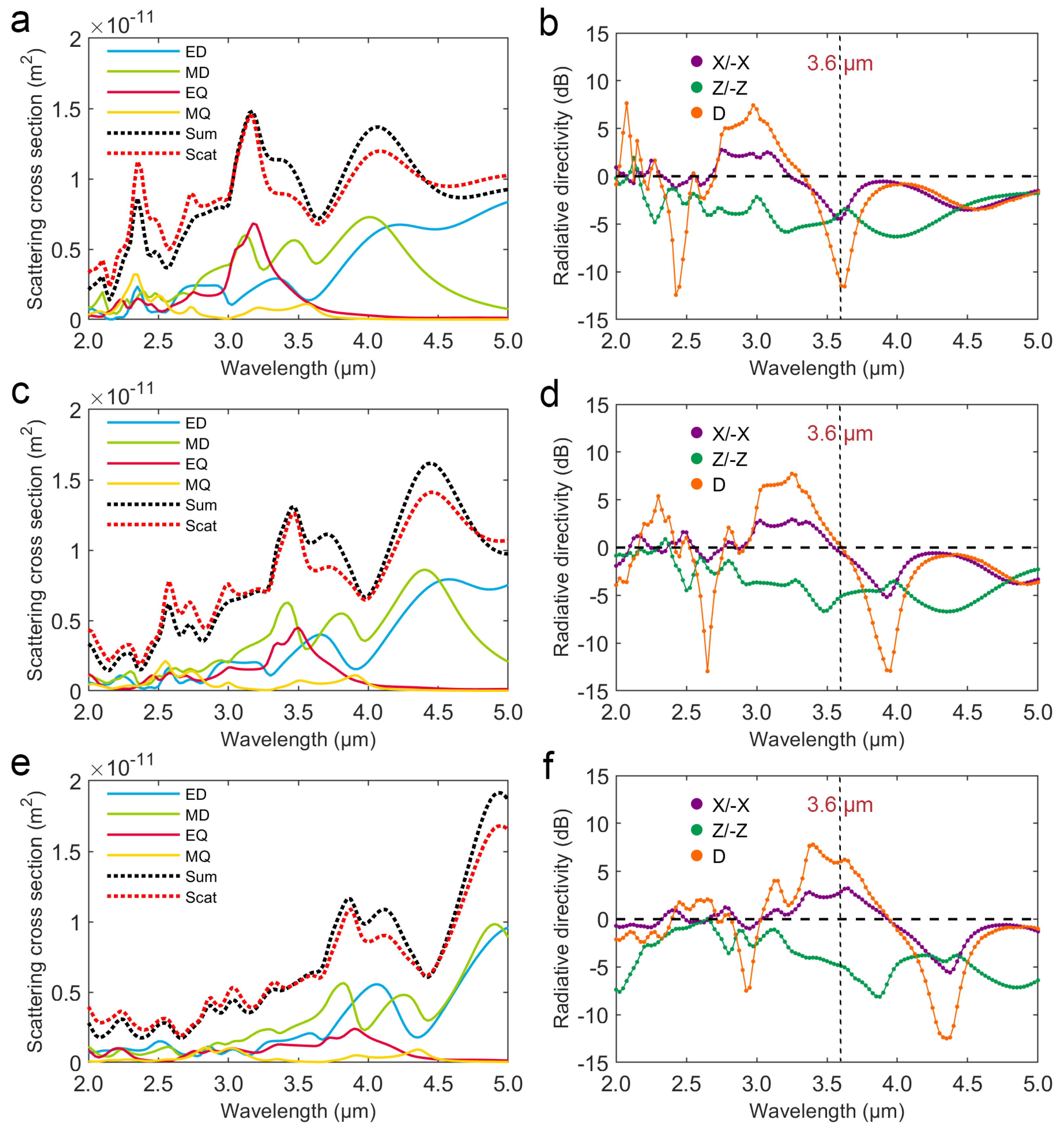
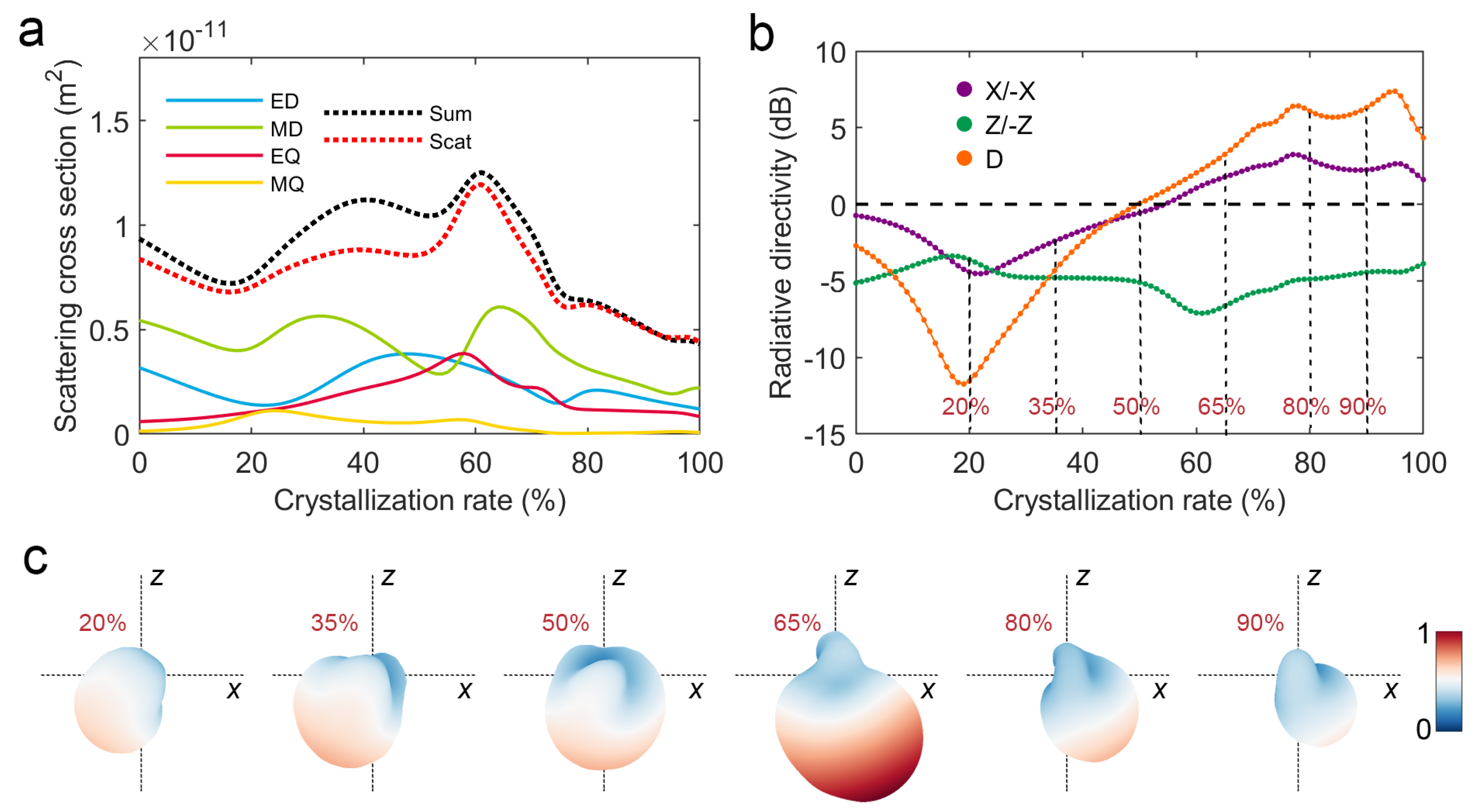
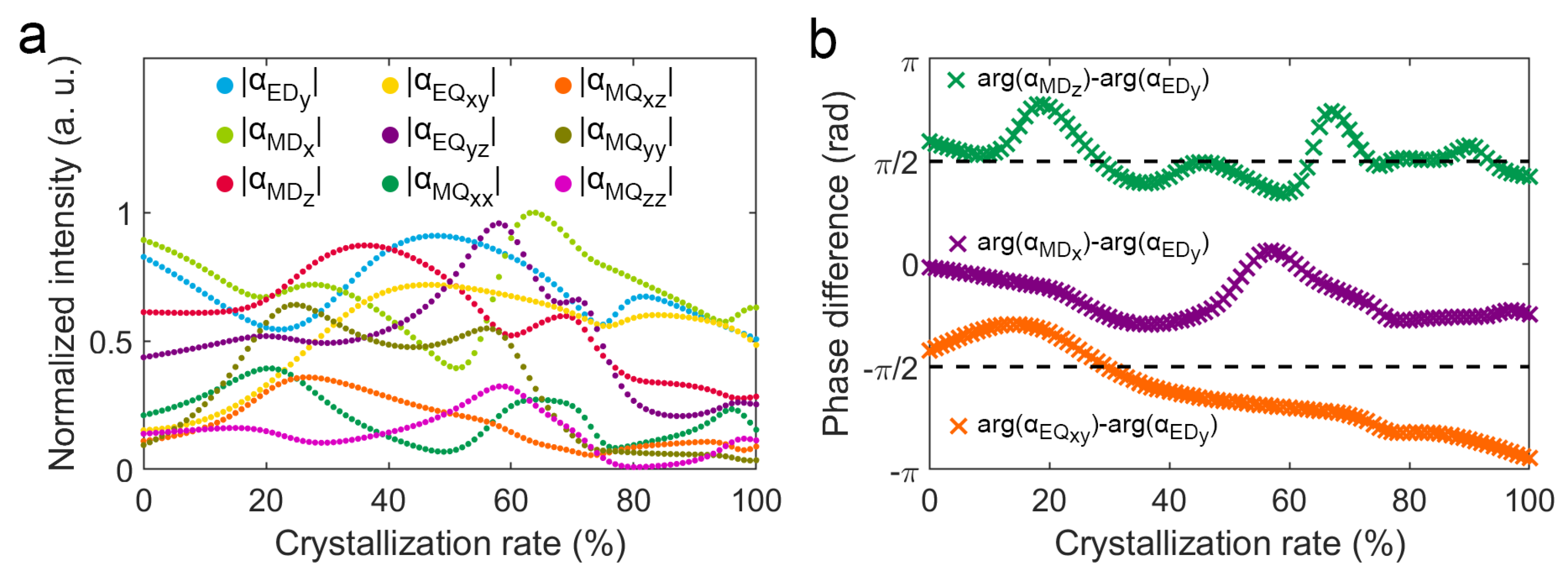
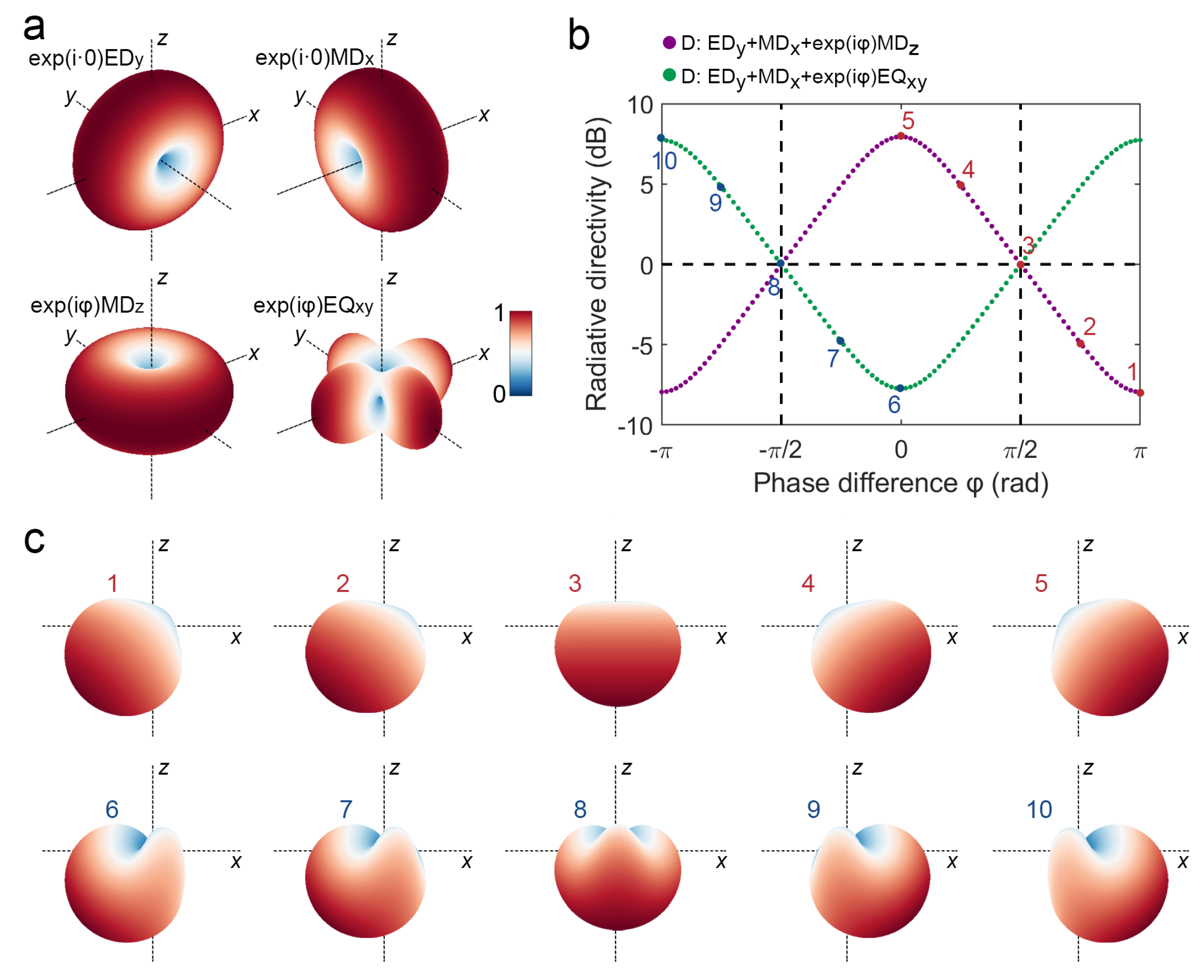
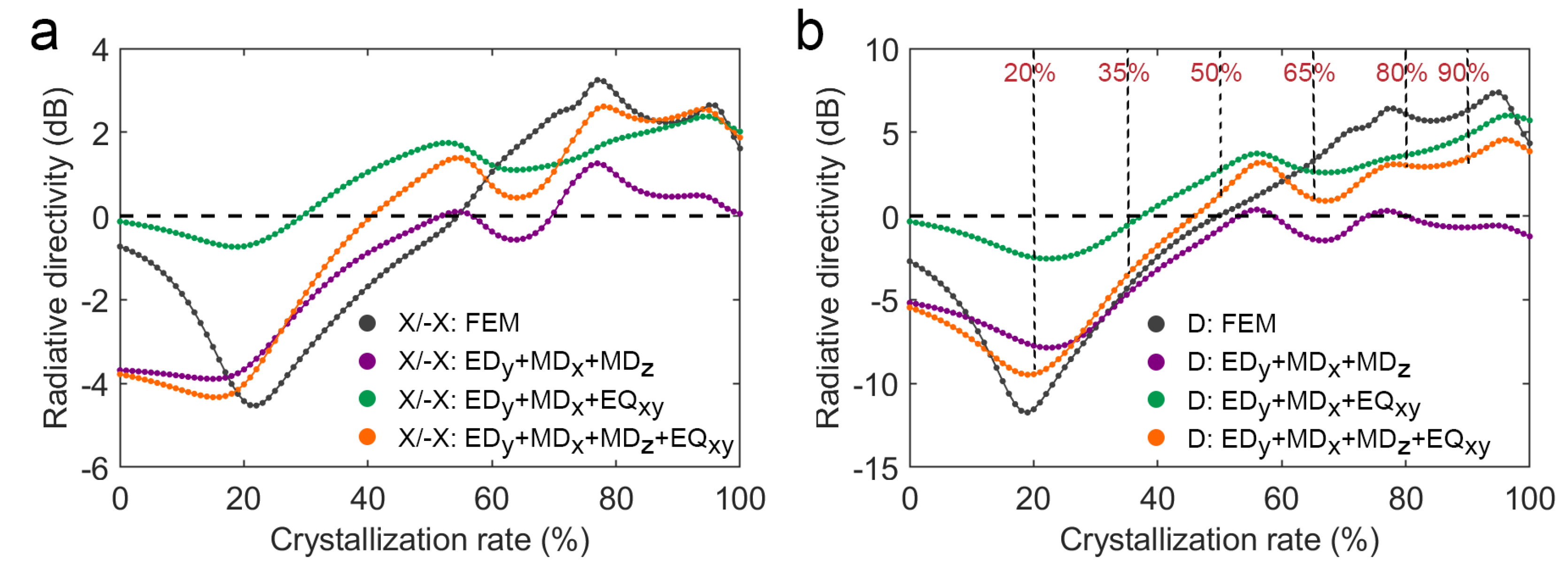
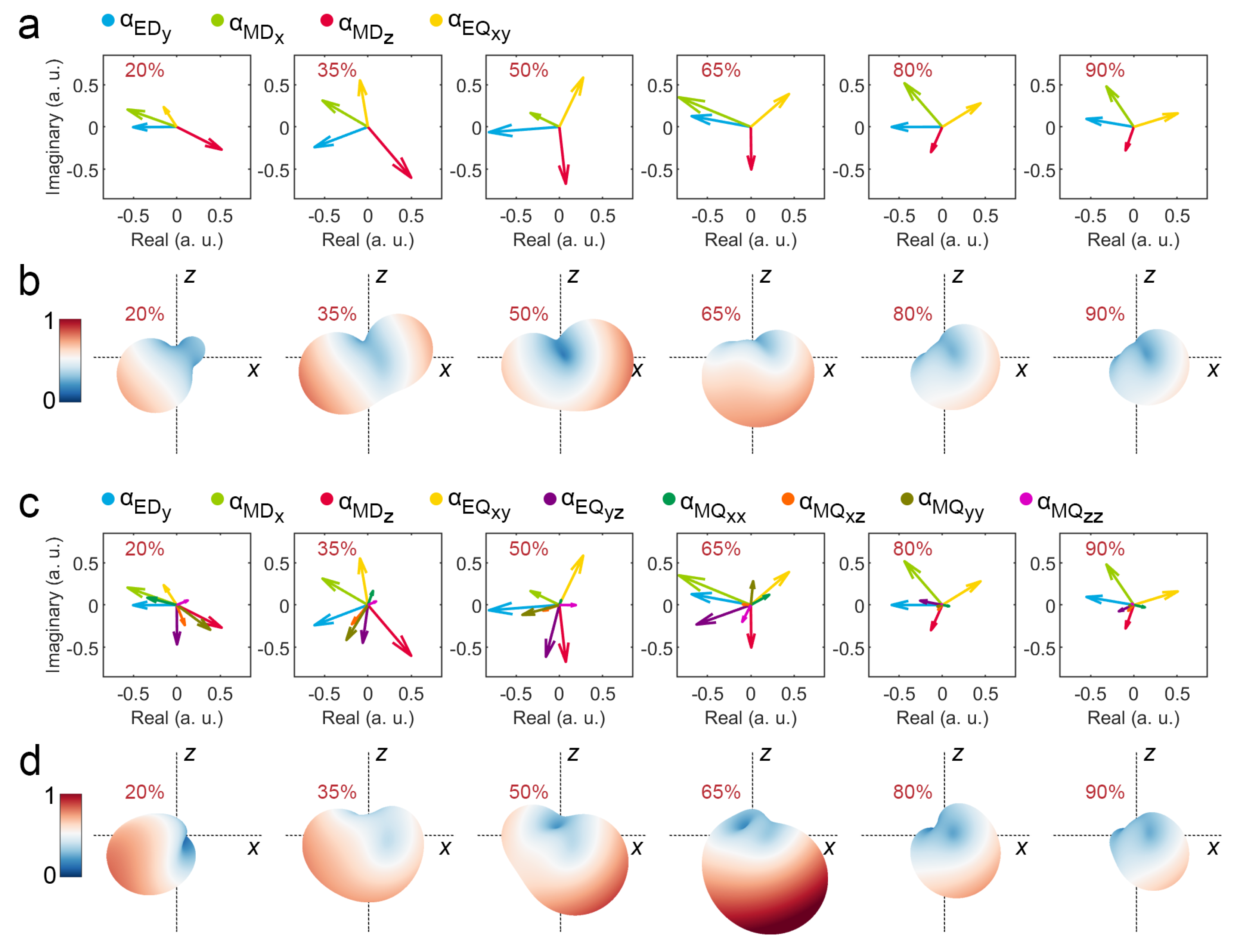
Publisher’s Note: MDPI stays neutral with regard to jurisdictional claims in published maps and institutional affiliations. |
© 2022 by the authors. Licensee MDPI, Basel, Switzerland. This article is an open access article distributed under the terms and conditions of the Creative Commons Attribution (CC BY) license (https://creativecommons.org/licenses/by/4.0/).
Share and Cite
Tang, P.; Tao, Q.; Liu, S.; Xiang, J.; Zhong, L.; Qin, Y. Reconfigurable Radiation Angle Continuous Deflection of All-Dielectric Phase-Change V-Shaped Antenna. Nanomaterials 2022, 12, 3305. https://doi.org/10.3390/nano12193305
Tang P, Tao Q, Liu S, Xiang J, Zhong L, Qin Y. Reconfigurable Radiation Angle Continuous Deflection of All-Dielectric Phase-Change V-Shaped Antenna. Nanomaterials. 2022; 12(19):3305. https://doi.org/10.3390/nano12193305
Chicago/Turabian StyleTang, Ping, Qiao Tao, Shengde Liu, Jin Xiang, Liyun Zhong, and Yuwen Qin. 2022. "Reconfigurable Radiation Angle Continuous Deflection of All-Dielectric Phase-Change V-Shaped Antenna" Nanomaterials 12, no. 19: 3305. https://doi.org/10.3390/nano12193305
APA StyleTang, P., Tao, Q., Liu, S., Xiang, J., Zhong, L., & Qin, Y. (2022). Reconfigurable Radiation Angle Continuous Deflection of All-Dielectric Phase-Change V-Shaped Antenna. Nanomaterials, 12(19), 3305. https://doi.org/10.3390/nano12193305





